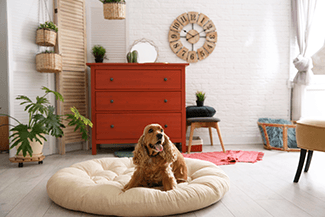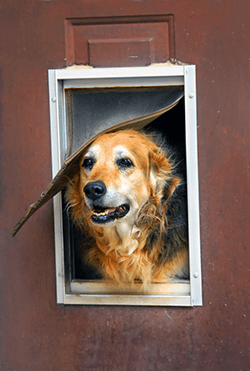Pets, like us, want to be comfortable and feel safe in their homes. We can’t cover all species of pets in this article such as birds, lizards, tortoises, gerbils, fish, and such, so the focus here is cats and dogs. You know cats, it’s all about them, anyway.
We certainly have a love affair with our furry friends. They provide us with security and emotional support in exchange for our responsibility to care for and protect them. Our homes are as varied as our pets’ personalities. How we make our pets part of our home will vary, too. Here are some ideas to enhance their experience in our homes without totally taking over (again, cue cats).
 Pet Rooms. If you have a spare room, be it a bedroom, unused office space, or even a walk-in closet, you could convert this to a safe place for your pets. Include comfortable beds, a lot of toys, and a water station. If the space has access to plumbing from an adjacent room, consider including a pet grooming station with a bathing sink. Consider the materials for flooring. Canine claws can scratch a soft flooring finish like some engineered wood products. Carpet fibers can easily be pulled from claws. A flooring that will withstand wet accidents and claws is best.
Pet Rooms. If you have a spare room, be it a bedroom, unused office space, or even a walk-in closet, you could convert this to a safe place for your pets. Include comfortable beds, a lot of toys, and a water station. If the space has access to plumbing from an adjacent room, consider including a pet grooming station with a bathing sink. Consider the materials for flooring. Canine claws can scratch a soft flooring finish like some engineered wood products. Carpet fibers can easily be pulled from claws. A flooring that will withstand wet accidents and claws is best.- Pet Spaces. This usually entails carving out a niche in a room whose primary use is human-based. A section of the living area, a piece of your office, or even a bedroom can be transformed into the place you want for your pet. Using a corner in an existing space inside is usually best. Some folks opt to create a space in their garage. This works only if the garage is temperature controlled for heating and cooling for your pets’ well-being. Keeping your pet in an unconditioned space is close to the equivalent of leaving them in a car, and we know THAT should NEVER EVER happen.
Arizonans love living outdoors. Having places for our pets outside is just as important. Under the canopy where we keep our outdoor furniture is a perfect place for a bed or cat tower. Protect these items from the elements to keep them in good condition for many years.

Making pet spaces comfortable is not our only responsibility for our friends. Their safety is also a concern that we need to address. Inside spaces tend to be a little easier to accomplish as opposed to exterior spaces.
- Interior Spaces. We tend to keep our homes in a fairly safe condition. If there are children at home, this suggestion almost goes without saying. But, we will say it anyway. Make sure caustic and poisonous materials are safely out of reach of your pets. This can include laundry soaps, cleaning products, paints and paint products, and medications tucked away where they cannot be reached. The products we tend to keep in our laundry rooms and garages are ones we generally do not want pets to get into. The same caution given to interior products applies to outdoor products, too. Keeping these types of products in a cabinet works unless your pet is part Houdini. In that case, you will need to take appropriate action. Another aspect of interior spaces to consider is the safety and well-being of the things you don’t want your pet getting into – shoes and electric cords!
- Exterior Spaces. Outside is great, but it brings a whole set of variables. Some of the same steps you would take to protect yourself and your children work to help make your yard pet-safe. Dave Munsey, the Fox 10 weatherman, always admonished us to “Watch your kids around water!” The same can be said for your pets. Pool safety is for them, too!
- Having a well-fenced yard, or a portion thereof, is a great way to keep your pets from running away and prevent other pets from interacting with them. Wildlife has been known to scale six-foot-tall walls in search of a meal. Your pet is just that to those critters, so be diligent. Another warning is appropriate here; if your yard is sprayed for pests, some products need 10 minutes to dry before becoming inert. That is when the spray is only dangerous to the pests it is focusing on. Keep your pets indoors while the yard is treated. Ask your pest control company what products they use and how long your pets should be kept out of the area after spraying.

Pet doors are not just for dogs. They provide a means for your pet to access the outside without engaging you. Convenience for both, we think.
Some things to consider when choosing the right door for your pets include:
- Size. Make sure the door is large enough for your pet to safely exit and re-enter the home. A door that is too small can cause your pet to get stuck and injured.
- Locate the door as close to your door as possible. If you already let your pet out through that door then training will be a bit easier.
- Make certain the flap closes tightly as possible. This might entail some maintenance on your part, including regular cleaning around the seal of dirt and other debris. A tight seal will help keep your energy bills from climbing.
Pet doors are great. We talked about the convenience earlier. There can be a downside, though. The pet door is an open invitation to several other critters to enter your home. Skunks, raccoons, and even wildcats can enter your home. Again bobcats, mountain lions, and coyotes can scale a tall fence to access your yard. A pet door may be another enticement. Here are some helpful tips you might want to use in conjunction with putting in a pet door:
- Keep pet food and water far away from the pet door. Most animals use scent as a guide. The smell of your pets’ food can be enticing to wildlife.
 Use an opaque door to decrease the attraction to light.
Use an opaque door to decrease the attraction to light.- Lock the pet door at night if you can. Most of the critters we don’t want in the house are nocturnal.
- Electronic openers can be paired with a microchip in your pet’s collar, opening and closing just for them.
- Install a motion-activated light outside. Often the sudden appearance of light will scare off the unwanted guest.
A pet door can be an opportunity for a thief to enter your home. Make the entrance inside through the pet door inaccessible to anything larger than Dachshund when no one is home. This is another reason the smart collar makes sense.
There have been instances where small children have used the pet door to gain access to the pool. Before anyone notices the child is not in the house, it can be too late. Make sure there is a locked fence around the pool to keep children and pets safe.
These tips should keep you and your pet safe to enjoy each other’s company. We would love to hear your stories about keeping your pets safe and some funny stories our furry friends can generate.
###
PODCAST
Pets are a part of the family too! We have tips to keep them safe and comfortable inside and out. Plus we answer some homeowner questions on an addition to a Santa Fe style home and our take on insulating the outside of block structures.
Podcast Archive With Expanded Content and Resources
PHOTO CREDIT
- Shutterstock
















